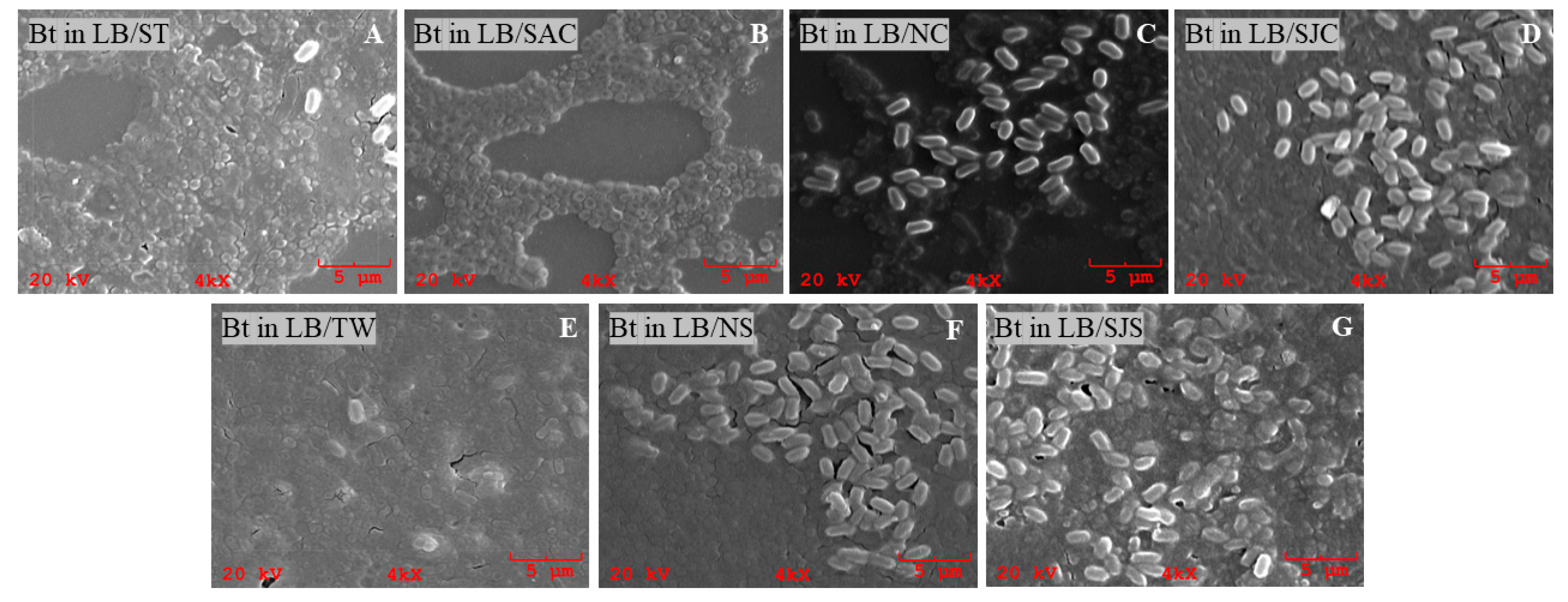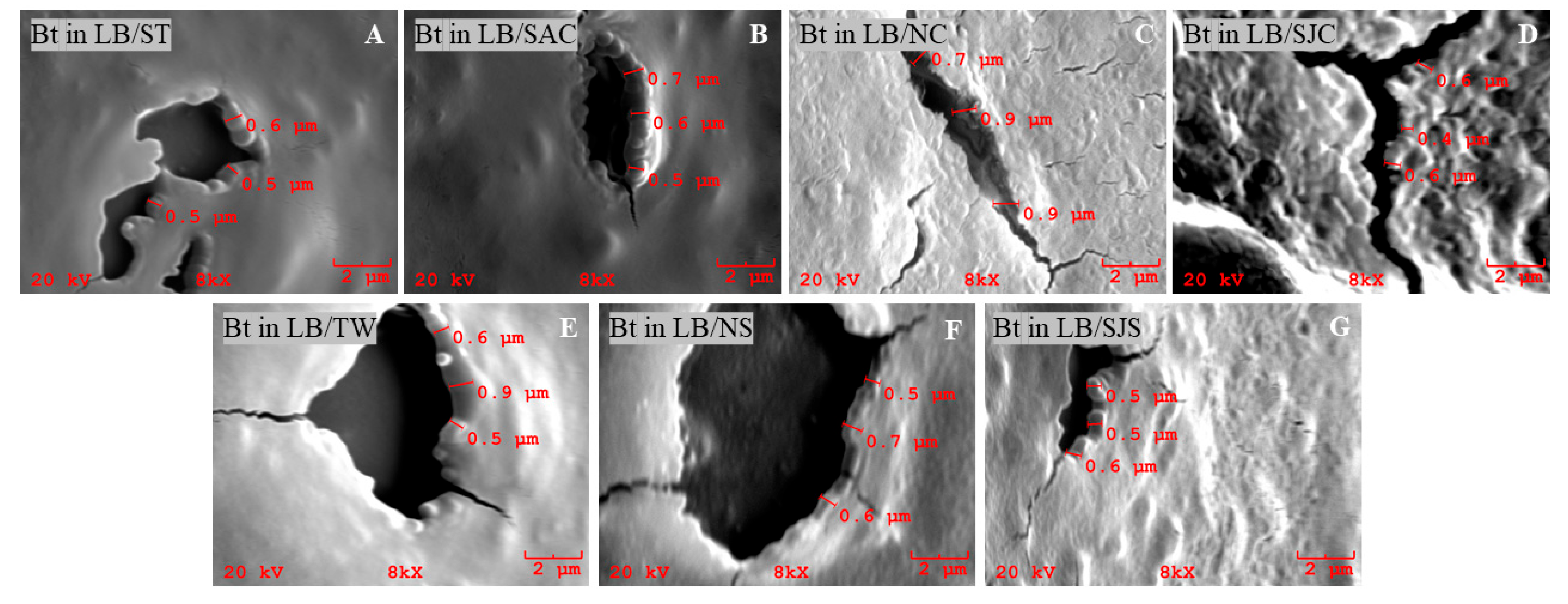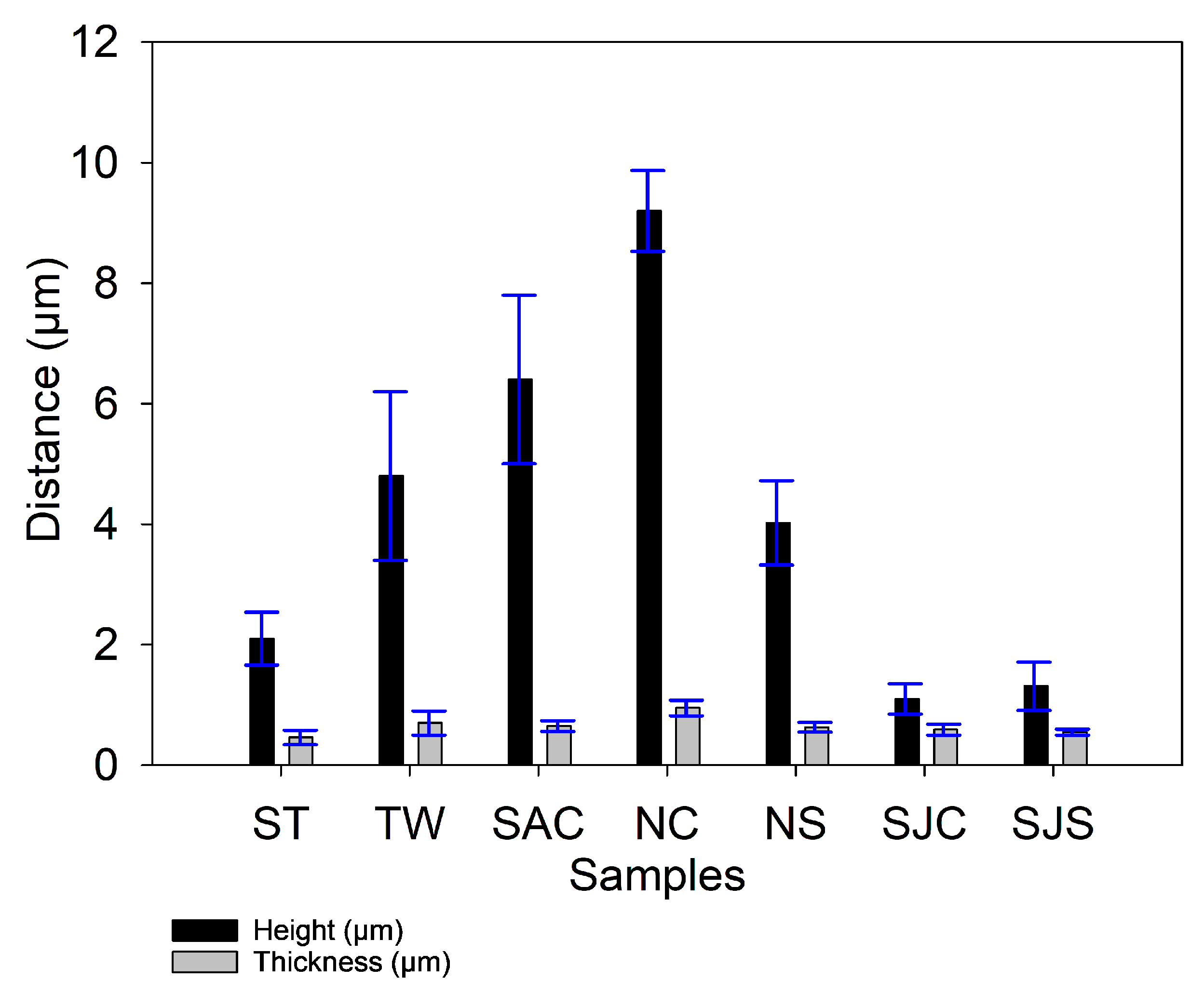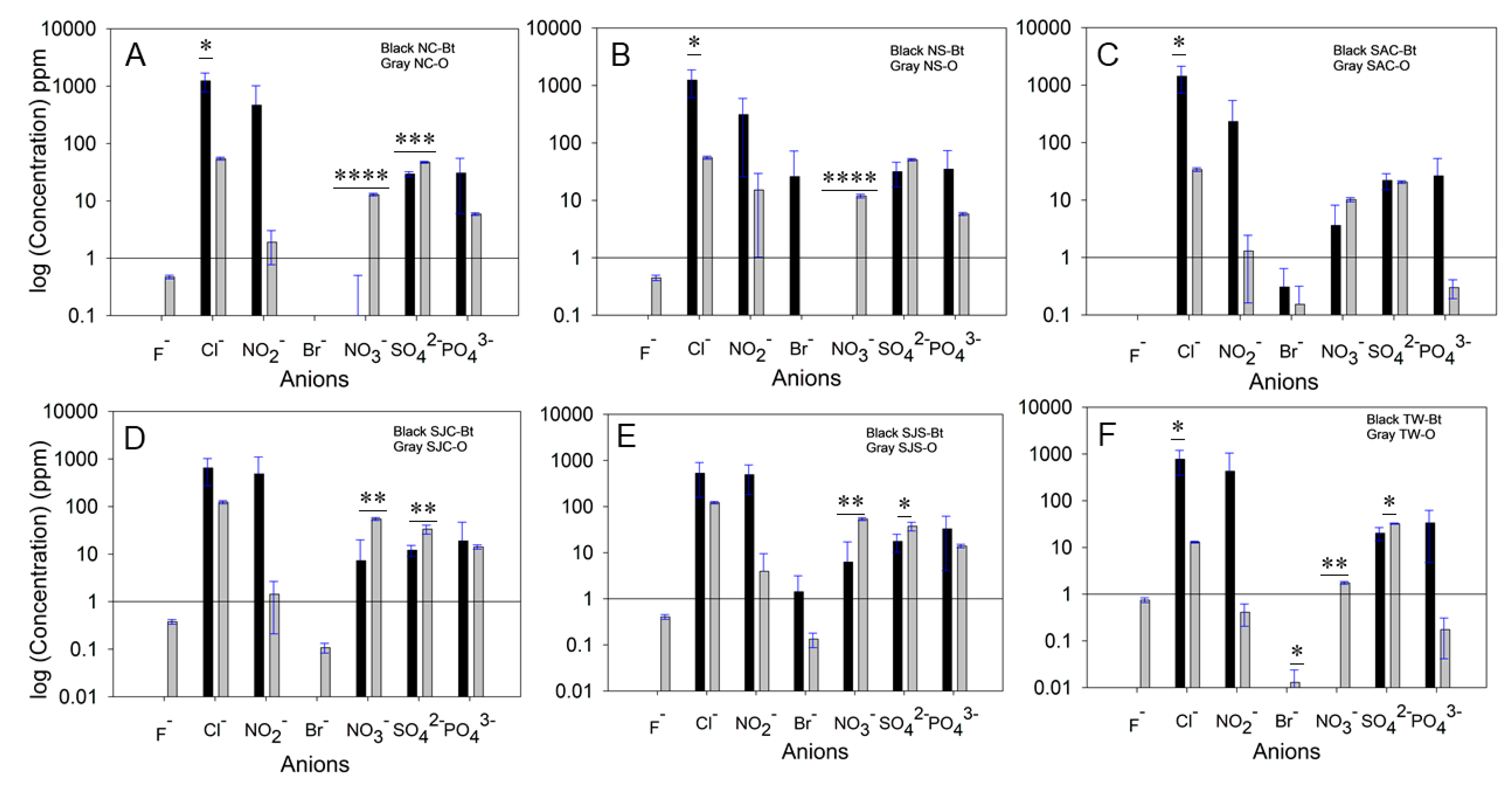Biofilm-Based Biomonitoring of Treated Wastewater Using Bacillus thuringiensis: Toward Sustainable Water Reuse
Abstract
1. Introduction
2. Materials and Methods
2.1. Sample Collection
2.2. Preparation of Bacillus thuringiensis Culture
2.3. Biofilm Formation Assay
- (i)
- Sterilized deionized water (ST);
- (ii)
- Tap water (TW);
- (iii)
- San Augustine Cl2-treated wastewater (SAC);
- (iv)
- Nacogdoches Cl2-treated wastewater (NC);
- (v)
- Nacogdoches SO2-treated wastewater (NS);
- (vi)
- San Jacinto Cl2-treated wastewater (SJC);
- (vii)
- San Jacinto SO2-treated wastewater (SJS).
2.4. Microscopy Analysis
2.5. Ion Chromatography (IC)
2.6. Statistical Analysis
3. Results
3.1. Biofilm Formation in Treated Wastewater
3.2. Scanning Electron Microscopy/Energy-Dispersive X-Ray Spectroscopy (SEM/EDS) Analysis
3.3. Ion Chromatography Studies of Supernatants After Biofilm Formation
4. Discussion
5. Conclusions
Supplementary Materials
Author Contributions
Funding
Institutional Review Board Statement
Informed Consent Statement
Data Availability Statement
Acknowledgments
Conflicts of Interest
References
- WHO. Water, Sanitation and Hygiene for Health: Guidelines on Safe Use of Wastewater in Agriculture; World Health Organization: Geneva, Switzerland, 2022. [Google Scholar]
- UNESCO. UN World Water Development Report 2021: Valuing Water; United Nations Educational, Scientific and Cultural Organization: Paris, France, 2021. [Google Scholar]
- Fernandes, J.; Ramísio, P.J.; Puga, H. A Comprehensive Review on Various Phases of Wastewater Technologies: Trends and Future Perspectives. Eng 2024, 5, 2633–2661. [Google Scholar] [CrossRef]
- Tchobanoglous, G.; Stensel, H.; Tsuchihashi, R.; Burton, F. Wastewater Engineering: Treatment and Resource Recovery, 5th ed.; Metcalf & Eddy, Inc., McGraw-Hill Education: Columbus, OH, USA, 2014. [Google Scholar]
- Chan, A.; Salsali, H.; McBean, E. Heavy Metal Removal (Copper and Zinc) in Secondary Effluent from Wastewater Treatment Plants by Microalgae. ACS Sustain. Chem. Eng. 2014, 2, 130–137. [Google Scholar] [CrossRef]
- Westgate, P.J.; Park, C. Evaluation of Proteins and Organic Nitrogen in Wastewater Treatment Effluents. Environ. Sci. Technol. 2010, 44, 5352–5357. [Google Scholar] [CrossRef] [PubMed]
- Zeiner, M.; Rezić, T.; Santek, B.; Rezić, I.; Hann, S.; Stingeder, G. Removal of Cr, Mn, and Co from textile wastewater by horizontal rotating tubular bioreactor. Environ. Sci. Technol. 2012, 46, 10690–10696. [Google Scholar] [CrossRef]
- Onchoke, K.K.; Janusa, M.A.; Sasu, S.A. Evaluation of the performance of a rural municipal wastewater treatment plant in Nacogdoches, East Texas (USA). Chem. Ecol. 2015, 31, 567–582. [Google Scholar] [CrossRef]
- Barber, L.B.; Keefe, S.H.; Antweiler, R.C.; Taylor, H.E.; Wass, R.D. Accumulation of contaminants in fish from wastewater treatment wetlands. Environ. Sci. Technol. 2006, 40, 603–611. [Google Scholar] [CrossRef]
- Kulwant, M.; Yadav, A. Challenges and Opportunities for Water Quality Monitoring and Management in India. In Integrated Management of Water Resources in India: A Computational Approach; Springer: Cham, Switzerland, 2024; pp. 121–137. [Google Scholar]
- USDA, U.S.E.P. Agency. Rural and Small Systems Guidebook to Sustainable Water and Wastewater Utility Management; EPA: Washington, DC, USA, 2025; pp. 1–40. [Google Scholar]
- Bernal, D. A conceptual model for decentralized municipal wastewater management. Water Pract. Technol. 2018, 13, 134–142. [Google Scholar] [CrossRef]
- Chirisa, I.; Bandauko, E.; Matamanda, A.; Mandisvika, G. Decentralized domestic wastewater systems in developing countries: The case study of Harare (Zimbabwe). Appl. Water Sci. 2017, 7, 1069–1078. [Google Scholar] [CrossRef]
- Tchobanoglous, G.; Burton, F.L.; Stensel, H.D. Wastewater Engineering, Treatment and Reuse, 4th ed.; McGraw-Hill: Boston, MA, USA, 2003. [Google Scholar]
- Sengupta, B.; Sinha, S.S.; Garner, B.L.; Arany, I.; Corley, C.; Cobb, K.; Brown, E.; Ray, P.C. Influence of Aptamer-Enclosed Silver Nanocluster on the Prevention of Biofilm by Bacillus thuringiensis. Nanosci. Nanotechnol. Lett. 2016, 8, 1054–1060. [Google Scholar] [CrossRef]
- Ianes, J.; Cantoni, B.; Polesel, F.; Remigi, E.U.; Vezzaro, L.; Antonelli, M. Monitoring (micro-)pollutants in wastewater treatment plants: Comparing discharges in wet- and dry-weather. Environ. Res. 2024, 263, 120132. [Google Scholar] [CrossRef]
- Guo, X.; Jiang, S.; Wang, Y.; Wang, Y.; Wang, J.; Huang, T.; Liang, H.; Tang, X. Effects of pre-treatments on the filtration performance of ultra-low pressure gravity-driven membrane in treating the secondary effluent: Flux stabilization and removal improvement. Sep. Purif. Technol. 2022, 303, 122122. [Google Scholar] [CrossRef]
- Flemming, H.-C.; Wingender, J.; Szewzyk, U.; Steinberg, P.; Rice, S.A.; Kjelleberg, S. Biofilms: An emergent form of bacterial life. Nat. Rev. Microbiol. 2016, 14, 563–575. [Google Scholar] [CrossRef] [PubMed]
- Costerton, J.W.; Stewart, P.S.; Greenberg, E.P. Bacterial biofilms: A common cause of persistent infections. Science 1999, 284, 1318–1322. [Google Scholar] [CrossRef]
- Mah, T.F.; O’Toole, G.A. Mechanisms of biofilm resistance to antimicrobial agents. Trends Microbiol. 2001, 9, 34–39. [Google Scholar] [CrossRef] [PubMed]
- Falkinham, J.O., 3rd; Hilborn, E.D.; Arduino, M.J.; Pruden, A.; Edwards, M.A. Epidemiology and Ecology of Opportunistic Premise Plumbing Pathogens: Legionella pneumophila, Mycobacterium avium, and Pseudomonas aeruginosa. Environ. Health Perspect. 2015, 123, 749–758. [Google Scholar] [CrossRef]
- Declerck, P. Biofilms: The environmental playground of Legionella pneumophila. Environ. Microbiol. 2010, 12, 557–566. [Google Scholar] [CrossRef]
- USEPA. Secondary Treatment Regulation: 40 CFR §133.102; Federal Register, U.S. Government Publishing Office: Washington, DC, USA, 1984. Available online: https://www.ecfr.gov/current/title-40/chapter-I/subchapter-D/part-133/section-133.102 (accessed on 31 July 2025).
- Madigan, M.T.; Bender, K.S.; Buckley, D.H.; Sattley, W.M.; Stahl, D.A. Brock Biology of Microorganisms, 16th ed.; Pearson: Boston, MA, USA, 2021. [Google Scholar]
- Beal, J.; Farny, N.G.; Haddock-Angelli, T.; Selvarajah, V.; Baldwin, G.S.; Buckley-Taylor, R.; Gershater, M.; Kiga, D.; Marken, J.; Sanchania, V.; et al. Robust estimation of bacterial cell count from optical density. Commun. Biol. 2020, 3, 512. [Google Scholar] [CrossRef]
- Wacogne, B.; Belinger Podevin, M.; Vaccari, N.; Koubevi, C.; Codjiová, C.; Gutierrez, E.; Davoine, L.; Robert-Nicoud, M.; Rouleau, A.; Frelet-Barrand, A. Concentration vs. Optical Density of ESKAPEE Bacteria: A Method to Determine the Optimum Measurement Wavelength. Sensors 2024, 24, 8160. [Google Scholar] [CrossRef]
- Goldstein, J.; Newbury, D.; Joy, D.; Lyman, C.; Echlin, P.; Lifshin, E.; Sawyer, L.; Michael, J. Scanning Electron Microscopy and X-ray Microanalysis, 4th ed.; Springer: Berlin/Heidelberg, Germany, 2018. [Google Scholar]
- Small, H.; Stevens, T.S.; Bauman, W.C. Novel ion exchange chromatographic method using conductimetric detection. Anal. Chem. 1975, 47, 1801–1809. [Google Scholar] [CrossRef]
- Onchoke, K.K.; Sasu, S.A. Determination of Hexavalent Chromium (Cr(VI)) Concentrations via Ion Chromatography and UV-Vis Spectrophotometry in Samples Collected from Nacogdoches Wastewater Treatment Plant, East Texas (USA). Adv. Environ. Chem. 2016, 2016, 3468635. [Google Scholar] [CrossRef]
- Perelomov, L.; Rajput, V.D.; Gertsen, M.; Sizova, O.; Perelomova, I.; Kozmenko, S.; Minkina, T.; Atroshchenko, Y. Ecological features of trace elements tolerant microbes isolated from sewage sludge of urban wastewater treatment plant. Stress Biol. 2024, 4, 8. [Google Scholar] [CrossRef]
- Learbuch, K.L.G.; Smidt, H.; van der Wielen, P. Water and biofilm in drinking water distribution systems in the Netherlands. Sci. Total Environ. 2022, 831, 154940. [Google Scholar] [CrossRef]
- Sharma, V.K.; Johnson, N.; Cizmas, L.; McDonald, T.J.; Kim, H. A review of the influence of treatment strategies on antibiotic resistant bacteria and antibiotic resistance genes. Chemosphere 2016, 150, 702–714. [Google Scholar] [CrossRef]
- Maurya, A.; Kumar, R.; Raj, A. Biofilm-based technology for industrial wastewater treatment: Current technology, applications and future perspectives. World J. Microbiol. Biotechnol. 2023, 39, 112. [Google Scholar] [CrossRef]
- Rizzo, L.; Manaia, C.; Merlin, C.; Schwartz, T.; Dagot, C.; Ploy, M.C.; Michael, I.; Fatta-Kassinos, D. Urban wastewater treatment plants as hotspots for antibiotic resistant bacteria and genes spread into the environment: A review. Sci. Total Environ. 2013, 447, 345–360. [Google Scholar] [CrossRef]
- Hasan, H.A.; Rahim, N.F.M.; Alias, J.; Ahmad, J.; Said, N.S.M.; Ramli, N.N.; Buhari, J.; Abdullah, S.R.S.; Othman, A.R.; Jusoh, H.H.W.; et al. A Review on the Roles of Extracellular Polymeric Substances (EPSs) in Wastewater Treatment: Source, Mechanism Study, Bioproducts, Limitations, and Future Challenges. Water 2024, 16, 2812. [Google Scholar] [CrossRef]
- Zhang, H.; Yuan, X.; Wang, H.; Ma, S.; Ji, B. Performance and Microbial Community of Different Biofilm Membrane Bioreactors Treating Antibiotic-Containing Synthetic Mariculture Wastewater. Membranes 2020, 10, 282. [Google Scholar] [CrossRef] [PubMed]
- Proia, L.; von Schiller, D.; Sànchez-Melsió, A.; Sabater, S.; Borrego, C.M.; Rodríguez-Mozaz, S.; Balcázar, J.L. Occurrence and persistence of antibiotic resistance genes in river biofilms after wastewater inputs in small rivers. Environ. Pollut. 2016, 210, 121–128. [Google Scholar] [CrossRef]
- Wingender, J.; Flemming, H.C. Biofilms in drinking water and their role as reservoir for pathogens. Int. J. Hyg. Environ. Health 2011, 214, 417–423. [Google Scholar] [CrossRef] [PubMed]
- Bridier, A.; Briandet, R.; Thomas, V.; Dubois-Brissonnet, F. Resistance of bacterial biofilms to disinfectants: A review. Biofouling 2011, 27, 1017–1032. [Google Scholar] [CrossRef] [PubMed]
- LeChevallier, M.W.; Babcock, T.M.; Lee, R.G. Examination and characterization of distribution system biofilms. Appl. Environ. Microbiol. 1987, 53, 2714–2724. [Google Scholar] [CrossRef]
- Berry, D.; Xi, C.; Raskin, L. Microbial ecology of drinking water distribution systems. Curr. Opin. Biotechnol. 2006, 17, 297–302. [Google Scholar] [CrossRef]
- Williams, D.T.; LeBel, G.L.; Benoit, F.M. Disinfection by-products in Canadian drinking water. Chemosphere 1997, 34, 299–316. [Google Scholar] [CrossRef]
- Hammes, F.; Berger, C.; Köster, O.; Egli, T. Assessing biological stability of drinking water without disinfectant residuals in a full-scale water supply system. J. Water Supply Res. Technol. AQUA 2010, 59, 31–40. [Google Scholar] [CrossRef]
- Li, S.; Duan, L.; Zhao, Y.; Gao, F.; Hermanowicz, S.W. Analysis of Microbial Communities in Membrane Biofilm Reactors Using a High-Density Microarray. Membranes 2023, 13, 324. [Google Scholar] [CrossRef] [PubMed]






| Parameter /WWTP | Nacogdoches WWTP | San Augustine WWTP | San Jacinto WWTP | |||||
|---|---|---|---|---|---|---|---|---|
| Influent | Effluent | Influent | Effluent | Influent | Effluent | USEPA Standard a | Percentage Removal | |
| CBOD (mg/L) | ND | 3.06 ± 0.17 | ND | 2.95 ± 0.58 | 189.88 ± 21.91 | 3.15 ± 0.15 | ≤25 mg/L (30-day avg), ≤40 mg/L (7-day avg) | 98.34% (SJ) |
| COD (mg/L) | ND | ND | ND | ND | 517.5 ± 3.54 | 51.35 ± 39.95 | 90.08% (SJ) | |
| TSS (mg/L) | - | 3.34 ± 0.36 | 2.87 ± 1.63 | 196.75 ± 21.35 | 2.90 ± 0.54 | ≤30 mg/L (30-day avg), ≤45 mg/L (7-day avg) | 98.53% | |
| DO (mg/L) | ND | 8.18 ± 0.16 | BD | 5.47 ± 0.45 | ND | 7.42 ± 0.01 | - | - |
| NH3-N (mg/L) | ND | 0.94 ± 0.55 | ND | 0.38 ± 0.29 | 35.69 ± 2.29 | 0.15 ± 0.07 | - | 99.58% |
| pH | 7.2 ± 0.12 | 6.50 ± 0.15 | ND | 7.13 ± 0.0 | 6.0–9.0 | |||
| Elements | ST | TW | SAC | NC | NS | SJC | SJS |
|---|---|---|---|---|---|---|---|
| C | 42.3 | 60.0 | 50.2 | 59.9 | 59.1 | 49.3 | 59.9 |
| N | 1.9 | 4.8 | 3.3 | 4.5 | 8.4 | 7.2 | 4.2 |
| O | 38.1 | 16.7 | 30.5 | 13.9 | 16.2 | 30.2 | 16.1 |
| F | 0.0 | 0.0 | 0.2 | 0.0 | 0.0 | 0.0 | 0.0 |
| Na | 4.0 | 4.2 | 3.0 | 5.2 | 4.2 | 3.2 | 5.1 |
| P | 5.0 | 5.6 | 6.0 | 7.7 | 5.6 | 4.3 | 4.9 |
| S | 2.4 | 2.5 | 2.8 | 2.8 | 1.9 | 2.3 | 1.6 |
| Cl | 1.6 | 2.9 | 0.7 | 3.7 | 2.7 | 0.7 | 5.2 |
| Br | 4.8 | 3.4 | 3.3 | 2.3 | 1.9 | 2.9 | 3.1 |
Disclaimer/Publisher’s Note: The statements, opinions and data contained in all publications are solely those of the individual author(s) and contributor(s) and not of MDPI and/or the editor(s). MDPI and/or the editor(s) disclaim responsibility for any injury to people or property resulting from any ideas, methods, instructions or products referred to in the content. |
© 2025 by the authors. Licensee MDPI, Basel, Switzerland. This article is an open access article distributed under the terms and conditions of the Creative Commons Attribution (CC BY) license (https://creativecommons.org/licenses/by/4.0/).
Share and Cite
Sengupta, B.; Ogunlewe, O.; Friedfeld, R.; Bess-Grunewald, C.; Baker, P.; Onchoke, K. Biofilm-Based Biomonitoring of Treated Wastewater Using Bacillus thuringiensis: Toward Sustainable Water Reuse. Sustainability 2025, 17, 7272. https://doi.org/10.3390/su17167272
Sengupta B, Ogunlewe O, Friedfeld R, Bess-Grunewald C, Baker P, Onchoke K. Biofilm-Based Biomonitoring of Treated Wastewater Using Bacillus thuringiensis: Toward Sustainable Water Reuse. Sustainability. 2025; 17(16):7272. https://doi.org/10.3390/su17167272
Chicago/Turabian StyleSengupta, Bidisha, Olabisi Ogunlewe, Robert Friedfeld, Cephus Bess-Grunewald, Philip Baker, and Kefa Onchoke. 2025. "Biofilm-Based Biomonitoring of Treated Wastewater Using Bacillus thuringiensis: Toward Sustainable Water Reuse" Sustainability 17, no. 16: 7272. https://doi.org/10.3390/su17167272
APA StyleSengupta, B., Ogunlewe, O., Friedfeld, R., Bess-Grunewald, C., Baker, P., & Onchoke, K. (2025). Biofilm-Based Biomonitoring of Treated Wastewater Using Bacillus thuringiensis: Toward Sustainable Water Reuse. Sustainability, 17(16), 7272. https://doi.org/10.3390/su17167272









